Author: The Editors
Good school, bad pupils, or vice versa?
21 December 2012 | This 'n' that

Number one: Finland. The Pearson analysis, 2012
Finland is used to feeling pretty good about itself when it comes to education. In the widely respected PISA tests – the Organisation for Economic Co-operation and Development’s exams in science and literacy – Finnish schoolchildren have, since the turn of the century, been outperforming most of their peers.
A shock came in 2009 when the tests revealed that Finnish kids were only third-best at reading, and sixth in maths; but by this time they were competing against the newly participating Asian countries, with their huge concentration on education.
Now, however, a new league table, drawn up by the education publishers Pearson, places Finland right at the top (2006–2010, 40 countries). Second place is held by South Korea; third is Hong Kong. The Pearson analysis uses a broader set of criteria, using not just test results but broader measures such as how many people go to university. In a result that is causing some puzzlement in the United Kingdom, Britain is rated sixth. Entirely, say critics, because British universities are so easy to get into.
The results are indeed flattering to Finland – but Finnish children’s motivation to learn is among the weakest in the survey’s countries. In reading, mathematics and the sciences Finns’ attitudes and application were low. It looks as if Finnish children consider school a place to hang out with their friends, not a place for teaching and learning. Countries where competition is stronger breed different attitudes.
So here’s the Finnish paradox: kids here hate school – yet still end up at the top of the list.
Must be something in the water.
Coming up…
14 December 2012 | This 'n' that
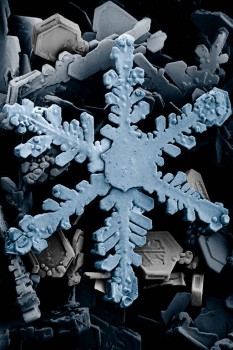
Natural art: hexaconal dendrite snowflake, magnified by an electron microscope and coloured. Photo: Beltsville Agricultural Research Unit, U.S. Dept. of Agriculture / Wikimedia Commons
Stop press: in a change to our advertised schedule, columnist Jyrki Lehtola reports on last week’s Finnish Independence Day shindig.
So our new Letter from the Editors, with appropriately festive themes, will appear next week.
Coming in from the cold
13 December 2012 | This 'n' that

Kulttuurisauna in Helsinki: design by Tuomas Toivonen and Nene Tsuboi
Kulttuurisauna, ‘The culture sauna’, will soon be opened in Helsinki as a part of the World Design Capital 2012 programme. The idea was developed into a project by architect Tuomas Toivonen and designer Nene Tsuboi, a Finnish-Japanese couple who will also run the sauna.
‘When we started considering the idea of building a public sauna in Helsinki, I realised that my dream job is to run a public sauna – offering people a place for cleansing, bathing and sharing quiet togetherness. We have been working in the field of design and architecture for 10 years now, and felt that we can use all of our skills in this project, developing a new public sauna in Helsinki; as a building, as a service and as an environment. By doing this, we want to contribute to the city, participating in making Helsinki more interesting and enjoyable’, says Tsuboi. More…
The Finlandia Prize for Fiction 2012
13 December 2012 | In the news
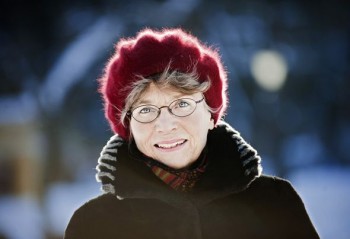
Ulla-Lena Lundberg. Photo: Cata Portin
The winner of the 29th Finlandia Prize for Fiction 2012, worth €30,000, is Ulla-Lena Lundberg for her novel Is (‘Ice’, Schildts & Söderströms), Finnish translation Jää (Teos & Schildts & Söderströms). The prize was awarded on 4 December.
The winning novel – set in a young priest’s family in the Åland archipelago – was selected by Tarja Halonen, President of Finland between 2000 and 2012, from a shortlist of six.
In her award speech she said that she had read Lundberg’s novel as ‘purely fictive’, and that it was only later that she had heard that it was based on the history of the writer’s own family; ‘I fell in love with the book as a book. Lundberg’s language is in some inexplicable way ageless. The book depicts the islanders’ lives in the years of post-war austerity. Pastor Petter Kummel is, I believe, almost the symbol of the age of the new peace, an optimist who believes in goodness, but who needs others to put his visions into practice, above all his wife Mona.’
Author and ethnologist Ulla-Lena Lundberg (born 1947) has since 1962 written novels, short stories, radio plays and non-fiction books: here you will find extracts from her Jägarens leende. Resor in hällkonstens rymd (‘Smile of the hunter. Travels in the space of rock art’, Söderströms, 2010). Among her novels is a trilogy (1989–1995) set in her native Åland islands, which lie midway between Finland and Sweden. Her books have been translated into five languages.
Appointed by the Finnish Book Foundation, the prize jury (researcher Janna Kantola, teacher of Finnish Riitta Kulmanen and film producer Lasse Saarinen) shortlisted the following novels: Maihinnousu (‘The landing’, Like) by Riikka Ala-Harja, Popula (Otava) by Pirjo Hassinen, Dora, Dora (Otava) by Heidi Köngäs, Nälkävuosi (‘The year of hunger’, Siltala) by Aki Ollikainen and Mr. Smith (WSOY) by Juha Seppälä.
Finlandia Junior Prize 2012
5 December 2012 | In the news
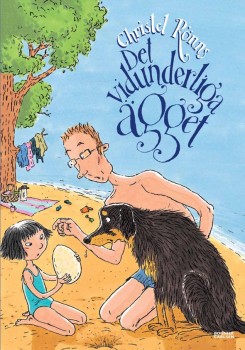 The Finlandia Junior Prize 2012 went to the illustrator and writer Christel Rönns for her book Det vidunderliga ägget (‘The extraordinary egg’, Söderströms & BonnierCarlsen).
The Finlandia Junior Prize 2012 went to the illustrator and writer Christel Rönns for her book Det vidunderliga ägget (‘The extraordinary egg’, Söderströms & BonnierCarlsen).
The winner was chosen from the shortlist of six by the film director and actor Mari Rantasila. Awarding the prize, worth €30,000, on 29 November she said:
‘The book has masterly, original and clear illustrations that support the story; the drawings include amusing details. It is refreshing to read a story about a family that all pulls in the same direction.
‘Det vidunderliga ägget deals with important matters, in a way that is suitable for small children: toleration of difference and the difficulty of loss, underlining that difference is not frightening or negative.’
The following five books also made it to the shortlist: Nörtti: new game (‘The nerd: new game’, Otava), about a schoolboy, bullying and social media by Aleksi Delikouras, Tatu ja Patu pihalla (‘Tatu and Patu on the yard’, Otava), a new picture book in the series about two curious little boys by Aino Havukainen and Sami Toivonen, Hurraa Helsinki! (‘Hurrah Helsinki!’, Tammi), a picture book about Helsinki by Karo Hämäläinen and Salla Savolainen, Puhelias Elias (‘Talkative Elias’, Tammi), an illustrated story about a little boy and his parent’s separation by Essi Kummu and Marika Maijala, and Kirkkaalla liekillä (‘With a bright flame’, Robustos), about 15-year-old Maaria, who lives through difficult times, by Venla Saalo.
Finlandia Prize for Non-Fiction 2012
5 December 2012 | In the news
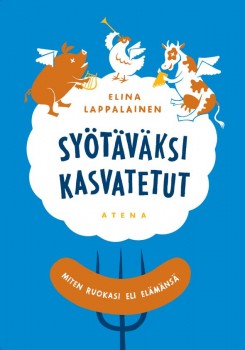 ‘It is one of the rules of quality journalism that writers aim for even-handed and impartial reporting, but at the same time challenge their respondents to account for their actions. Writers should also have the capacity for in-depth reporting and analysis,’ said Janne Virkkunen, former Editor-in-Chief of Helsingin Sanomat newspaper on 8 November, as he announced the winner of this year’s Finlandia Prize for Non-Fiction, worth €30,000.
‘It is one of the rules of quality journalism that writers aim for even-handed and impartial reporting, but at the same time challenge their respondents to account for their actions. Writers should also have the capacity for in-depth reporting and analysis,’ said Janne Virkkunen, former Editor-in-Chief of Helsingin Sanomat newspaper on 8 November, as he announced the winner of this year’s Finlandia Prize for Non-Fiction, worth €30,000.
The winner, Syötäväksi kasvatetut. Miten ruokasi eli elämänsä (‘Grown to be eaten. How your food lived its life’, Atena) by the young journalist Elina Lappalainen, is her first book.
‘The book could have fallen prey to the sensationalism of which we all probably have experience in the media, at least. This writer was able to avoid the temptation,’ Janne Virkkunen said.
The other works on the shortlist of six were as follows: Arabikevät (‘The Arab spring’, Avain), a study of spring 2011 in the Arab world by Lilly Korpiola and Hanna Nikkanen, Norsusta nautilukseen. Löytöretkiä eläinkuvituksen historiaan (‘From the elephant to the nautilus. Explorations into the illustration of animals’, John Nurminen Foundation) by Anto Leikola, Kevyt kosketus venäjän kieleen (‘A light touch to the Russian language’, Gaudeamus) by professor of Russian Arto Mustajoki, Karhun kainalossa. Suomen kylmä sota 1947–1990 (‘Under the arm of the Bear. Finland’s Cold War 1947–1990’, Otava) by Jukka Tarkka and Markkinat ja demokratia. Loppu enemmistön tyrannialle (‘Market and democracy. The end of the tyranny of the majority’, Otava) by banker Björn Wahlroos.
How cool is Stinky?
30 November 2012 | This 'n' that
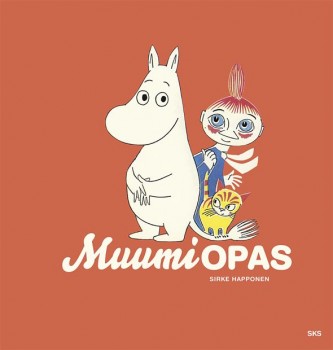
Moomintroll and Mymble: positive role models
‘What reigns in Moomin Valley is a rock-hard hierarchy of those who are cool (Snufkin, Moominmamma, Little My), those who need to be those who are cool (Moomintroll, the Snork Maiden, Sniff, one or two Whompers and Toffles), and those who are absurd (the Hemulen, the Fillyjonk, the Muskrat)’, noted Pia Ingström in her review (Books from Finland 2/2008) of Sirke Happonen’s dissertation on Tove Jansson’s characters.
Snufkin? Fillyjonk? The Moomin world, created by the versatile Finland-Swedish writer and artist Tove Jansson (1914–2001), is peopled with funny-shaped Moomins and a great variety of other creatures who may look a bit odd at first but who are very… human. Jansson’s books have been translated into more than 40 languages. More…
Finlandia Prize for Fiction candidates 2012
23 November 2012 | In the news
The candidates for the Finlandia Prize for Fiction 2012 were announced on 15 November. They are Riikka Ala-Harja, Pirjo Hassinen, Heidi Köngäs, Ulla-Lena Lundberg, Aki Ollikainen and Juha Seppälä.
Their novels, respectively, are Maihinnousu (‘The landing’, Like), Popula (Otava), Dora, Dora (Otava), Is (‘Ice’, Schildts & Söderströms), Nälkävuosi (‘The year of hunger’, Siltala) and Mr. Smith (WSOY).
The jury – researcher Janna Kantola, teacher of Finnish Riitta Kulmanen and film producer Lasse Saarinen – made their choice out of ca. 130 novels. The winner, chosen by Tarja Halonen, who was President of Finland between 2000 and 2012, will be announced on 4 December. The prize, awarded since 1984, is worth 30,000 euros.
The jury’s chair, Janna Kantola, commented: ‘One of this year’s recurrent themes is the Lapland War [of 1944–1945]. Writers appear to be pondering the role of Germany in both the Second World War and in contemporary Europe. Social phenomena are examined using satire; the butt is the birth and activity of extremist political movements. Economics, the gutting of money and market forces, are present, as in previous years, but now increasingly with a sense of social responsibility.’
Popula deals with people involved in a contemporary populist political party. Dora, Dora describes Albert Speer’s journey to Finnish Lapland in 1943. Nälkävuosi depicts the year of hunger in Finland, 1868. Is takes place in the Finnish archipelago of the post-war years. Mr. Smith portrays greed and the destructive power of money both in Russian and Finnish history as well as in contemporary Finland. Maihinnousu, set in Normandy, depicts a child’s serious disease in a family that is going through divorce.
On life and death
23 November 2012 | In the news
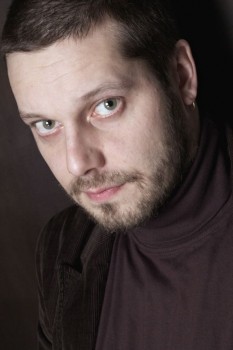
Aki Ollikainen. Photo: Laura Malmivaara
On 15 November Helsingin Sanomat Literature Prize, the Helsinki newspaper’s prize for the best first work of the year, worth €15,000, was awarded for the 18th time.
The winner was journalist Aki Ollikainen (born 1973) with his first novel Nälkävuosi (‘The hunger year’, Siltala). The jury made the choice from 80 first works.
The hard years of 1867 and 1868 almost a tenth of the Finnish population died of hunger and diseases. Nälkävuosi portrays poor people in the country who are forced to leave home and look for any food they can find, and well-to-do gentlemen in town who can afford to amuse themselves with women, for example. This slim novel speaks of life and death; finally, after a deadly winter there will be new hope for better times.
Renaissance man
19 November 2012 | This 'n' that
 The graphic designer Professor Erik Bruun has been awarded the Helsinki Design Award, created to celebrate World Design Capital Helsinki 2012.
The graphic designer Professor Erik Bruun has been awarded the Helsinki Design Award, created to celebrate World Design Capital Helsinki 2012.
Worth 10,000 euros, this special one-off award is intended to highlight the remarkable work of Erik Bruun (born 1926). His internationally recognised life’s work – from the 1950s onwards – includes commercial posters, book and journal design, logotypes, postage stamps and bank notes, photography and nature posters. Recently his best designs of the 1950s have been experiencing a renaissance as, for example, printed material and posters.
Finnish nature, its flora and fauna, in particular endangered species, have been close to his heart, and his Saimaa ringed seal poster became the emblem of the Finnish Association for Nature Conservation.
Erik worked with us at Books from Finland as Art Editor from 1976 to 1990. He has lived for decades in an old wooden house on the UNESCO World Heritage Site islands of Suomenlinna (Sveaborg) in Helsinki harbour, and his observations of his winged friends, various sea birds, were often the subject of discussion over Books from Finland layouts.
The logo he created for Books in 1978, a quill with an eagle’s eye, featured on the covers of almost 50 issues of the journal; the illustration here, with the text Images from Finland, is from a catalogue introducing graphics and poems from a portfolio published by Eurographica in 1978.
Our editorial process went digital in the early 1990s – but Erik still works with his quills and pens, not with computers.
Congratulations!
Stories in stone
9 November 2012 | This 'n' that
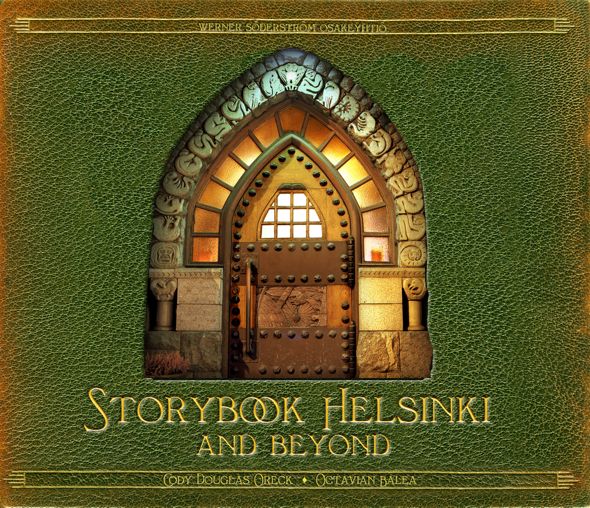 Birds and bees, frogs, squirrels, water lilies, thistles, ferns, junipers, bears and even gnomes originating in Finnish nature appear, in abundance, in Finnish architecture of the two decades around the turn of the 20th century.
Birds and bees, frogs, squirrels, water lilies, thistles, ferns, junipers, bears and even gnomes originating in Finnish nature appear, in abundance, in Finnish architecture of the two decades around the turn of the 20th century.
The trend that developed out of the Arts and Crafts Movement in Great Britain and in the United States, known as l’art nouveau in France and Jugendstil in Germany, lived a short but extremely fervent life in Finland, which adopted the term jugend.
In Finland this aesthetic movement is also called national romanticism. In 1899 the pan-Slavic movement arising in Russia took the form of attempts to suppress Finland’s burgeoning national identity in Finland, and in resisting this, artists made extensive use of national romantic material in their work. More…
Helsinki Book Fair 2012
25 October 2012 | In the news
 The twelfth Helsinki Book Fair opens today at the Exhibition and Convention Centre. Last year the Fair attracted more than 80,000 visitors.
The twelfth Helsinki Book Fair opens today at the Exhibition and Convention Centre. Last year the Fair attracted more than 80,000 visitors.
During four days around 700 interviews and discussions with writers will take place on twelve stages, and there will be more than 300 exhibitors in the various fields of literature.
Author Jari Tervo has been nominated the Book Fair Club’s columnist: in his first contribution, entitled ‘Median myllyt’ (‘The mills of the media’) Tervo says, among other things:
‘During the last 30 years the amount of public attention directed at Finnish authors has probably multiplied by ten. How has it affected the sales of literature? Not at all. The sales haven’t multiplied by ten, or even doubled. Has the increased public attention affected the content of literature? I don’t think it has….
‘The media doesn’t churn authors in its mill because literature is so exceedingly important. To the media the authors are a biomass that is able to articulate a touch more juicily than the average celebrity. An author needs less editing. It’s as simple as that.’
This time the featured country is Hungary: the guest writers are György Spiró, Sandor Zsigmond Papp, Vilmos Csaplár, Péter Esterházy and Léda Forgó. There are 30 guests from 11 countries.
The prize Rakkaudesta kirjaan, ‘Out of love for the book’, was awarded posthumously to the writer, critic and editor Jarmo Papinniemi (1968–2012), who, according to the jury of literary experts was an exceptionally versatile professional working in the field of the arts.
It’s a long way to Cameroon
18 October 2012 | This 'n' that
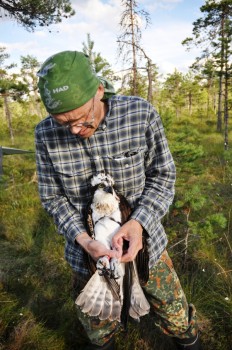
Before takeoff: Ilmari looks slightly annoyed here, as his ankle rings are checked by Harri Koskinen before his release. Photo: Juhani Koivu
An eight-year-old Finnish male, named Ilmari, has emigrated to Africa; on 13 October he was spotted in Cameroon. He set off for the journey on 16 September.
At the beginning of his journey, in Hattula, southern Finland, in August, he weighed 1,370g.
Ilmari is an osprey. The Osprey Foundation (more photos here too) fitted him with a Microwave GPS-Argos satellite transmitter (weighing just 30g and running on solar power). This allows osprey researchers to follow his journeys.
Actually Ilmari hasn’t emigrated – he will return to where he was born, in March 2013. As this is Ilmari’s first recorded migration, his final destination is not known. But one of his countrymen (-birds), carrying a transmitter, Jukka, liked it so much in Cameroon that he spent the winter there. Will Ilmari do the same? Watch this space!
The journeys of Finnish migrating birds are long (in this case, more than 6000 kilometres) and dangerous, so we wish Ilmari safe travel back home as well.
Best-selling books in September
18 October 2012 | In the news
Number one on the September list of best-selling Finnish fiction titles, compiled by the Finnish Booksellers’ Association, is Sofi Oksanen’s new novel Kun kyyhkyset katosivat (‘When the doves disappeared’, Like): which shot straight to the top of the list on its publication in August.
The huge national and international success of her previous novel, Puhdistus – in English, Purge – published in 2008 and also set in Estonia, has paved the way for Kun kyyhkyset katosivat; translation rights have been sold to several countries already.
Number two on the list was Riikka Pulkkinen’s third novel, Vieras (‘The stranger’, Otava). In third and fourth places were two new thrillers, Paholaisen pennut (‘The devil’s cubs’, Tammi), by Leena Lehtolainen, and Ylösnousemus (‘Resurrection’, WSOY), by Ilkka Remes.
In fifth place was Sirpa Kähkönen’s novel Hietakehto (‘Sand cradle’, Otava): number six in her series set in the Kuopio region of eastern Finland, during the Second World War.
The non-fiction (translated foreign as well as Finnish) list was topped by Blaine Harden’s Escape from Camp 14 (in North Korea; Gummerus). The variety of subjects on this list can be surprising: number two is about angels (Lorna Byrne’s A Message of Hope from the Angels, Otava), number three a biography of a Finnish ex-con turned surgeon (Veitsen terällä, ‘On knife’s edge’, by Arno Kotro & Christer Lybäck, Otava), number four about the Cold War in Finland (Jukka Tarkka: Karhun kainalossa, ‘Under the arm of the bear’, Otava) and number five about cupcakes (by Angela Drake, Otava)…
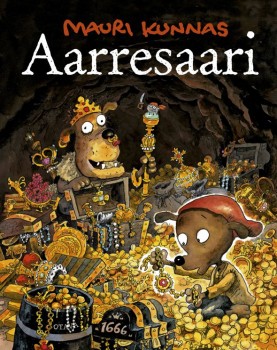
Mauri Kunnas: Aarresaari
The three best-selling children’s books were by seasoned Finnish authors: illustrator-writer Mauri Kunnas, with his tribute to R.L Stevenson, Aarresaari (‘Treasure island’, Otava), Aino Havukainen & Sami Toivonen, with Tatu ja Patu pihalla (‘Tatu and Patu outdoors’, Otava) and Sinikka Nopola & Tiina Nopola, with their Risto Räppääjä ja nukkavieru Nelli (‘Risto Rapper and Threadbare Nelly’, Tammi).
Jarmo Papinniemi in memoriam 1968–2012
9 October 2012 | In the news
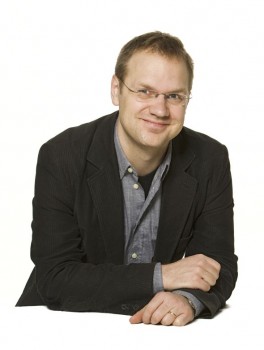
Jarmo Papinniemi
The editor, literary critic and writer Jarmo Papinniemi has died of a sudden illness in Helsinki.
Two days later, the latest edition of Parnasso was published: Papinniemi became editor-in-chief of this august 60-year-old literary magazine in 2005. During his period as editor, the magazine’s readership increased, quite an achievement in the difficult world of periodicals.
Jarmo Papinniemi worked as a literary critic and as a news and arts reporter for Finnish Broadcasting Company from 1998 to 2005. He wrote and directed television documentaries, and was the author of numerous books on literature and music, including Aloittamisen taito (‘The art of beginning’, 2010, with Kaisa Neimala) and Sävelten siivillä (‘On the wings of music’, 2011), a study of the work of the composer Ilkka Kuusisto.
Jarmo was also a member of the Editorial Board of Books from Finland from 2002. He was a quick, industrious and knowledgeable reader and writer whose opinions were well grounded and expressed, and he was interested in an unusually wide range of culture. Cheerful, humorous, a connoisseur of music, Jarmo was a colleague with whom conversations were always enjoyable and thought-provoking; he will be greatly missed by all of us who worked with him.
